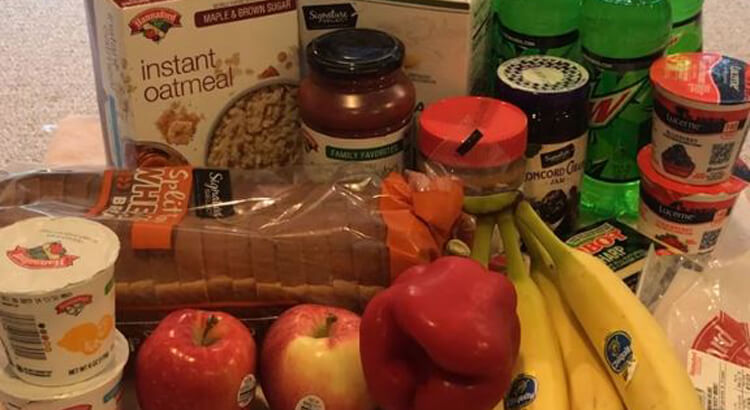I’m fortunate to work for a company that challenges me to improve not just professionally, but also personally.
National Life has adopted a cause to help end childhood hunger in Vermont, and recently introduced employees to the 3Squares Challenge.
3Squares is a federal program that provides food assistance (formerly food stamps) to those who qualify. The average 3Squares benefit is less than $37 a week, or just $5.22 a day. The 3Squares Challenge helps us better understand what it’s like to deal with hunger by asking participants to eat only food purchased within those constraints.
I recently took the 3Squares Challenge, and participating in it has changed my perspective. From carefully planning my budget to feed myself for the work week, to thinking about how it felt to eat yet another peanut butter and jelly sandwich while my colleagues enjoyed a variety of delicious lunches from the cafeteria, I learned several things:
- Store brands, sales, and coupons were my friends – When working through my budget, it quickly became apparent how important every penny would be. Most of the products I ended up purchasing were store brands. The quantity of food available to me for the week would have been much smaller had I opted for the more expensive name brands, and I based several purchases on what happened to be on sale or what I found a coupon for (or both in the case of some delicious Cabot cheese!). For the week I spent $24.16.
- Location and transportation are critical – I live in a town where there are a Hannaford supermarket, Shaw’s grocery store, and Wal-Mart within walking distance of one another. So I was able to comparison shop among the stores. Saving 50 cents here and a quarter there made a huge difference in the amount of food I was able to purchase. The challenge would have been greater if I had fewer options or had to spend time and money traveling to a faraway store with lower prices.
- I got embarrassed at the deli counter – One of the luxuries I budgeted for was half a pound of the least expensive turkey breast that was on sale at Hannaford. When the woman at the deli got done cutting the meat, it weighed in at over three-quarters of a pound. I knew my budget was tight, so I asked her to take off a couple slices. After she did that, it still weighed in at 0.57 pounds. I then sheepishly asked her to please take off another slice, at which point I got an exasperated “are you kidding me?” kind of look from her and the fellow behind me in line. The result of that moment of embarrassment was sticking to my budget, so it was worth it, but it still didn’t feel good. I can’t imagine what it would be like to regularly have a much worse feeling in the checkout line or while watching classmates or friends eat lunch, as our teammates have shared in their compelling stories.
- Meals got boring pretty quickly – I had instant oatmeal for breakfast five days in a row. For lunches and dinners, I had four peanut butter and jelly sandwiches, three turkey and cheese sandwiches, and pasta and sauce three times. Add in a pepper, a big bag of store brand potato chips, a couple apples, some yogurt, and bananas, and that was my week – except for the free items I scarfed down at a team party and when a colleague brought in donuts!
- I understand how nutrition can be a problem – My diet likely had more carbohydrates than normal, but it definitely had less protein, vitamins, minerals, and fat. When I compared the store-brand instant oatmeal I bought with the organic oatmeal our family often eats, I was shocked at how much more salt and sugar was added to my diet. I lost three pounds last week, which was fine for an overweight, middle-aged man who knew he would only be eating like this for five days. The potential difficulties for a growing child having a diet worse than mine for years on end are hard to comprehend, and heartbreaking.
- How could our family survive on a 3Squares budget? – I generally eat like a college student to begin with and was able to purchase things I knew I liked. But my wife and children each have different preferences and nutritional needs. One of my daughters also has severe allergies, meaning we regularly purchase some specialty products that are fairly expensive. What kinds of trade-offs would we have to make to purchase food that was safe for her to eat? Or would we decide to save money by buying things that might put her at greater risk of an anaphylactic reaction? We’re blessed that for our family this is a theoretical exercise – but it’s upsetting to realize choices like these are the reality for thousands of Vermonters.
- I’m not sure what to do next – Every month our church collects food for the Williston Food Shelf, and we usually donate a few bags of groceries with staples similar to what I ate last week – pasta, sauce, peanut butter, jelly, cereal, crackers, canned tuna, etc. Based on my experience, I thought there must be more nutritious products we could share with our neighbors, but when I visited the food shelf’s website, the items they were most in need of were almost exactly what we had been donating! While we’ll continue to contribute to the food shelf, I want to do more to help.
Any ideas?
TC110433(1019)3

